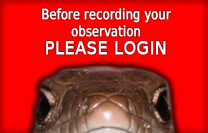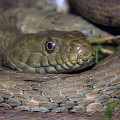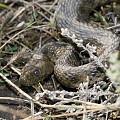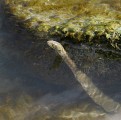
The DICE SNAKE's total (body+tail) length is up to 100 cm, but usually shorter. Females are longer and bulkier than males. Head elongate, and more flattened than grass snake, with large, protuberant eyes on top of head. Pupil round and black, with golden iris. Ground colour greenish-brown, greyish-green or ochre with dark spots or squares in alternate rows (tessellate). Ground colour lighter towards the belly. Some specimens may be plain (without spots) or jet black. Belly reddish, yellowish or off-white with dark brown or black squares forming checkerboard pattern. Dorsal scales strongly keeled. ly signifies males, which may also have ring markings (ocelli). Young are similar to adults, but sometimes darker.
Distibution map by our National Herpetological Mapping Program:




















